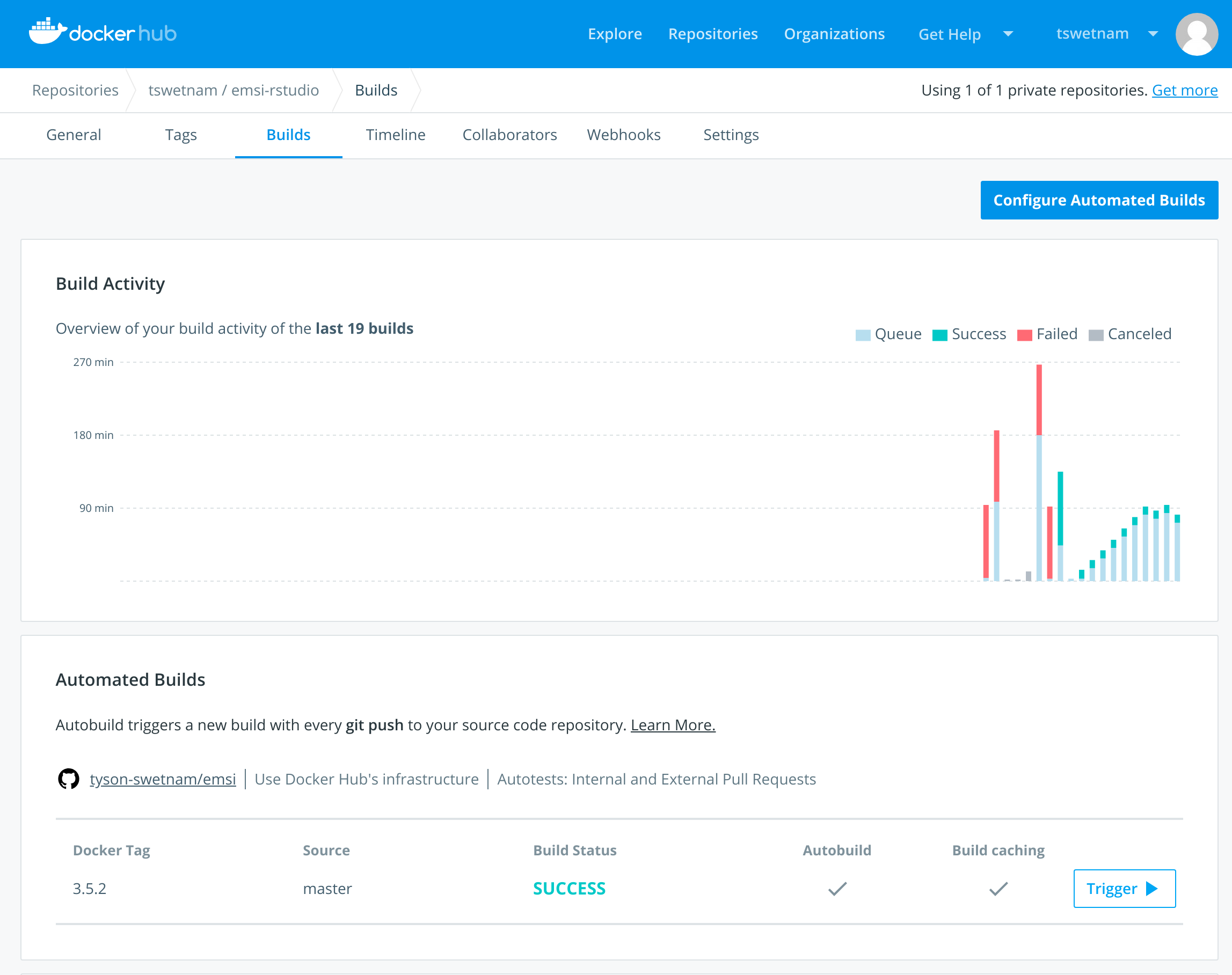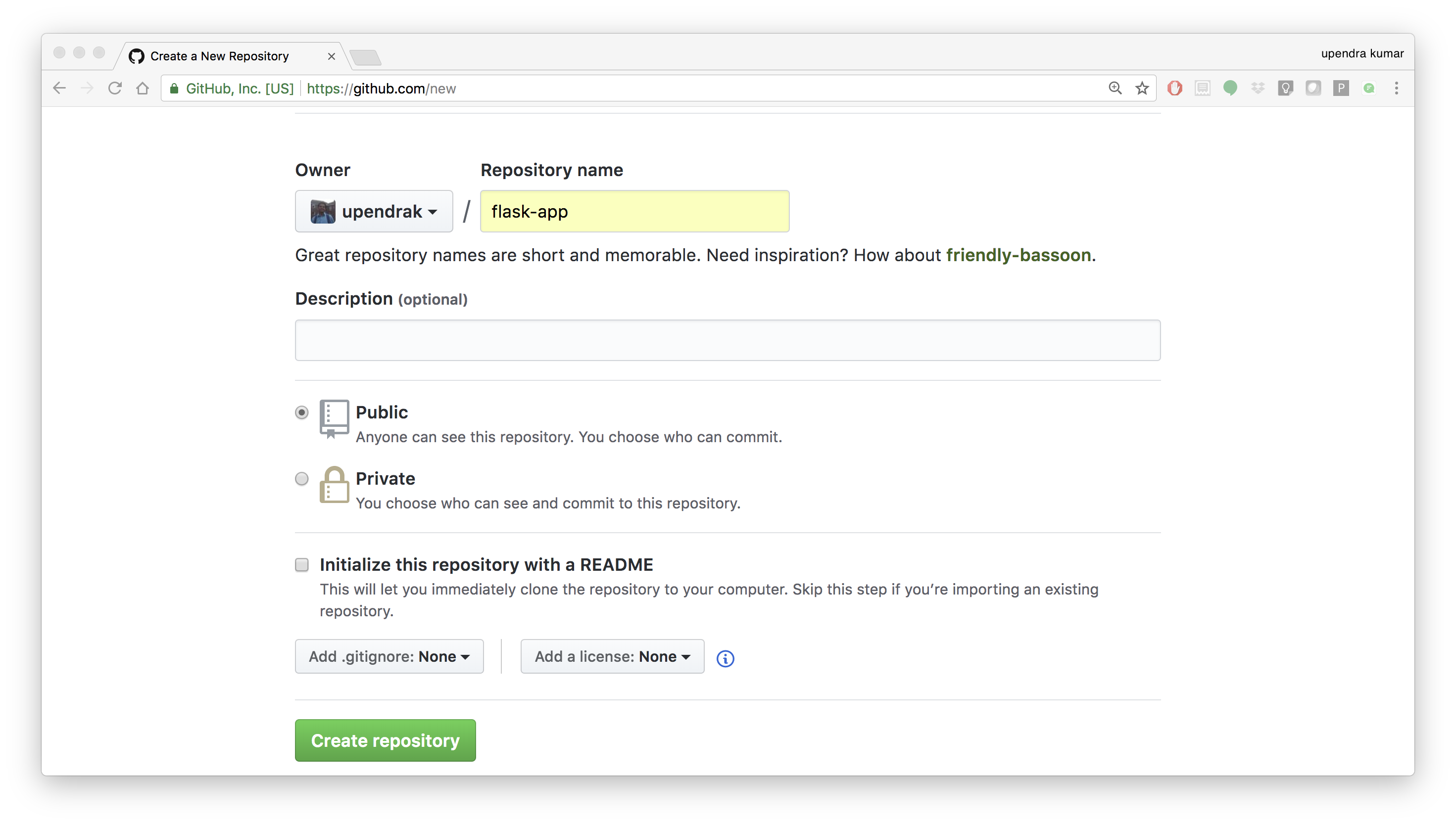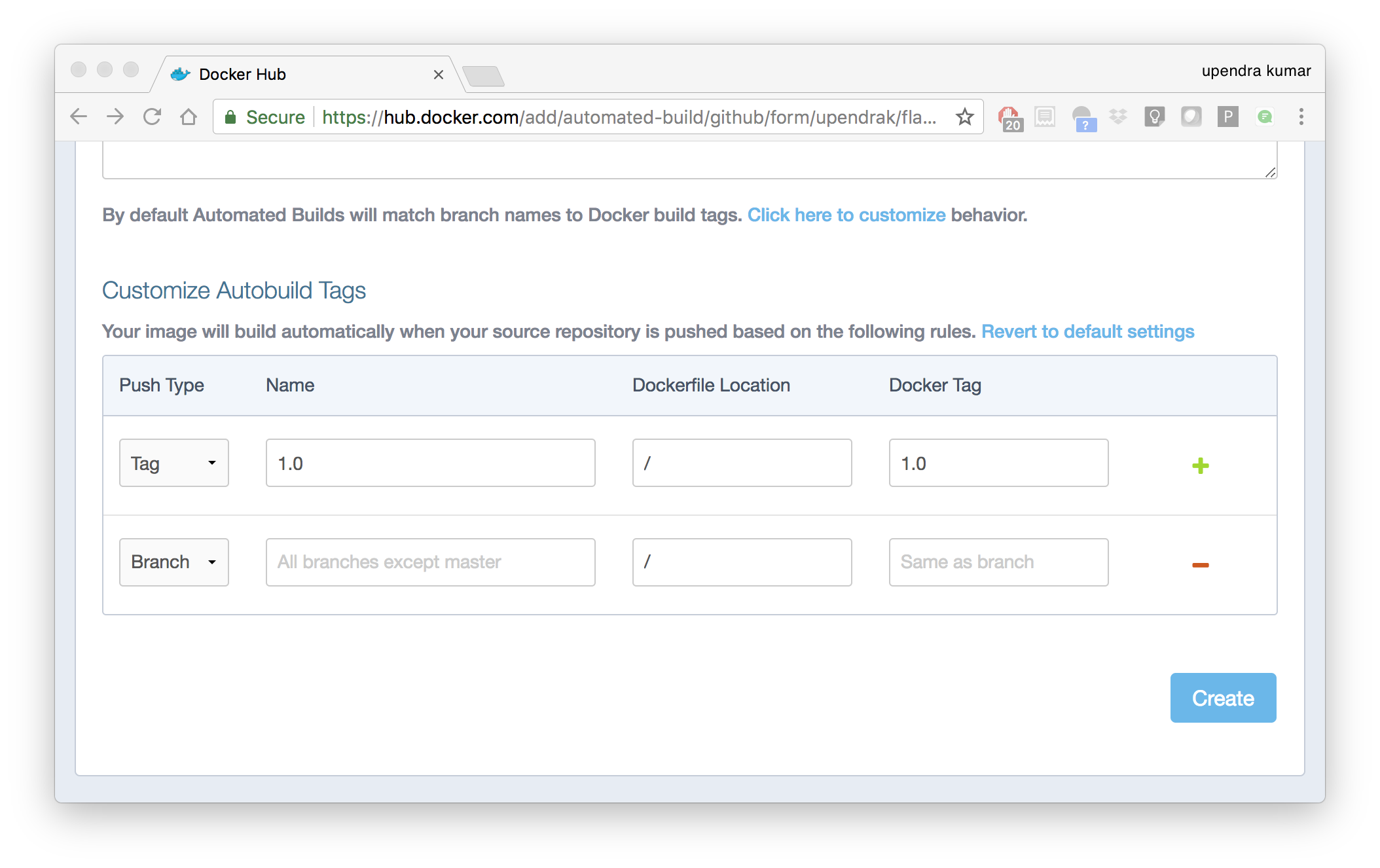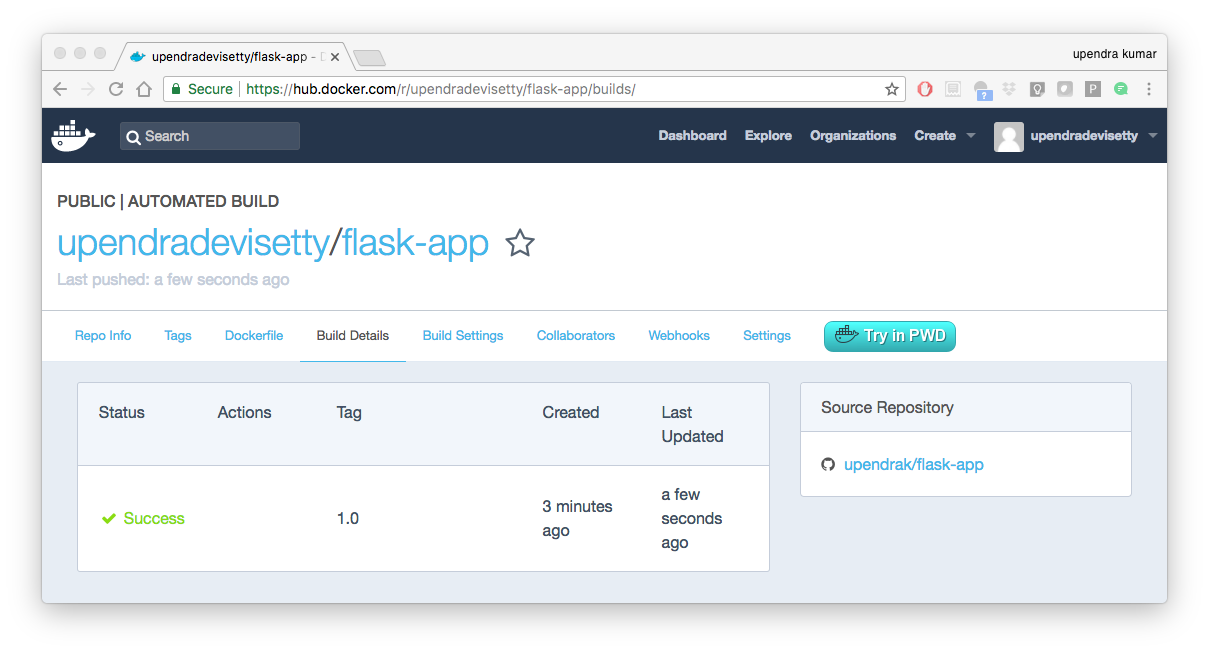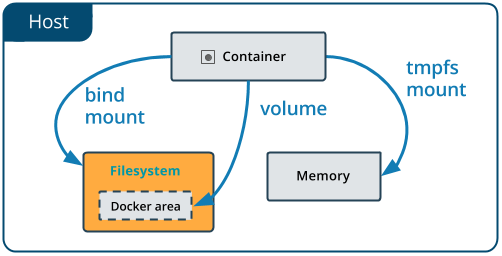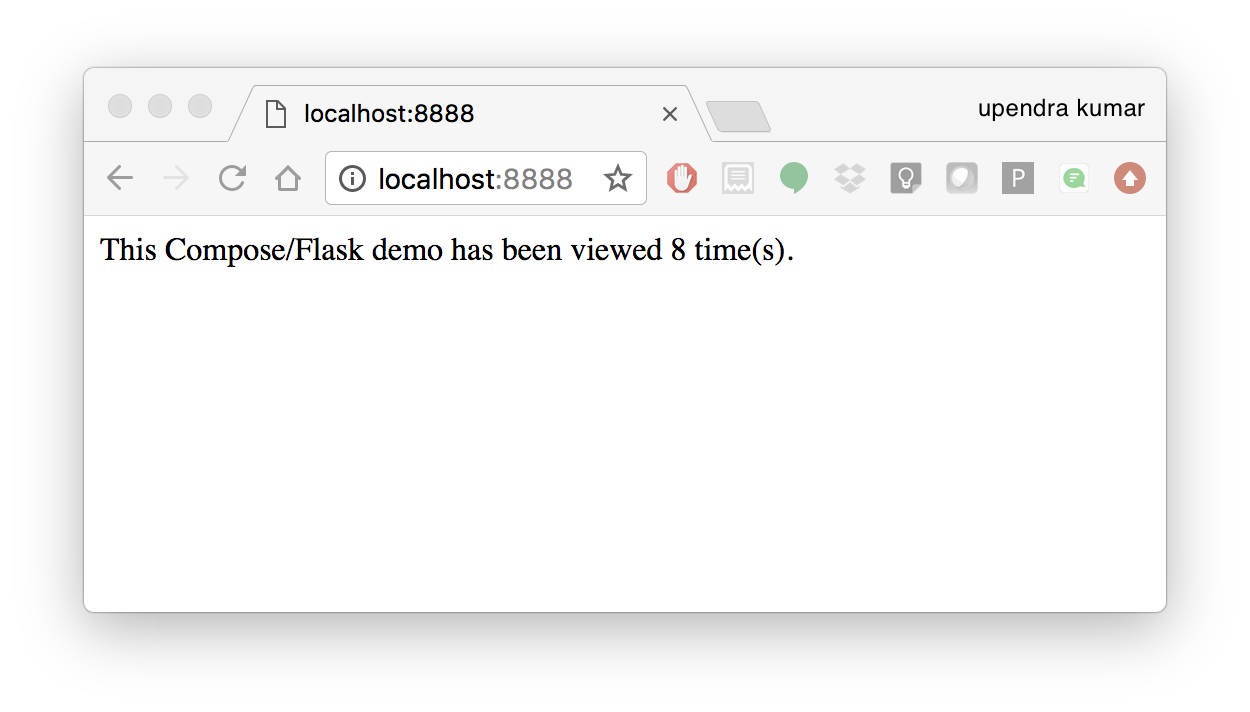Advanced Docker¶
Automated Docker image building from GitHub¶
An automated build is a Docker image build that is triggered by a code change in a GitHub or Bitbucket repository. By linking a remote code repository to a Dockerhub automated build repository, you can build a new Docker image every time a code change is pushed to your code repository.
A build context is a Dockerfile and any files at a specific location. For an automated build, the build context is a repository containing a Dockerfile.
Automated Builds have several advantages:
Images built in this way are built exactly as specified.
The Dockerfile is available to anyone with access to your Docker Hub repository.
Your repository is kept up-to-date with code changes automatically.
Automated Builds are supported for both public and private repositories on both GitHub and Bitbucket.
Prerequisites¶
To use automated builds, you first must have an account on Docker Hub and on the hosted repository provider (GitHub or Bitbucket). While Docker Hub supports linking both GitHub and Bitbucket repositories, here we will use a GitHub repository. If you don’t already have one, make sure you have a GitHub account. A basic account is free
Note
If you have previously linked your Github or Bitbucket account, you must have chosen the Public and Private connection type. To view your current connection settings, log in to Docker Hub and choose Profile > Settings > Linked Accounts & Services.
Building Windows containers is not supported.
Link your Docker Hub account to GitHub¶
Log into Docker Hub.
Click “Create Repository+”
Click the Build Settings and select
GitHub.
The system prompts you to choose between Public and Private and Limited Access. The Public and Private connection type is required if you want to use the Automated Builds.
Press
Selectunder Public and Private connection type. If you are not logged into GitHub, the system prompts you to enter GitHub credentials before prompting you to grant access. After you grant access to your code repository, the system returns you to Docker Hub and the link is complete.
After you grant access to your code repository, the system returns you to Docker Hub and the link is complete. For example, github linked hosted repository looks like this:
Automated Container Builds¶
Automated build repositories rely on the integration with a version control system (GitHub or Gitlab) where your Dockerfile is kept.
Let’s create an automatic build for our container using the instructions below:
Initialize git repository for the mynotebook directory you created for your
Dockerfile
$ git init
Initialized empty Git repository in /home/julianp/mynotebook/.git/
$ git status
On branch master
Initial commit
Untracked files:
(use "git add <file>..." to include in what will be committed)
Dockerfile
model.py
nothing added to commit but untracked files present (use "git add" to track)
$ git add * && git commit -m "Add files and folders"
[master (root-commit) a4f732a] Add files and folders
2 files changed, 10 insertions(+)
create mode 100644 Dockerfile
create mode 100644 model.py
Create a new repository on github by navigating to this URL - https://github.com/new
Note
Don’t initialize the repository with a README and don’t add a license.
Push the repository to github
$ git remote add origin https://github.com/<your-github-username>/mynotebook.git
$ git push -u origin master
Counting objects: 7, done.
Delta compression using up to 8 threads.
Compressing objects: 100% (5/5), done.
Writing objects: 100% (7/7), 1.44 KiB | 0 bytes/s, done.
Total 7 (delta 0), reused 0 (delta 0)
To https://github.com/<your-github-username>/mynotebook.git
* [new branch] master -> master
Branch master set up to track remote branch master from origin.
Select
Create>Create Automated Buildfrom Docker Hub.
The system prompts you with a list of User/Organizations and code repositories.
For now select your GitHub account from the User/Organizations list on the left. The list of repositories change.
Pick the project to build. In this case
mynotebook. Type in “Jupyter Test” in the Short Description box.If you have a long list of repos, use the filter box above the list to restrict the list. After you select the project, the system displays the Create Automated Build dialog.
Note
The dialog assumes some defaults which you can customize. By default, Docker builds images for each branch in your repository. It assumes the Dockerfile lives at the root of your source. When it builds an image, Docker tags it with the branch name.
Customize the automated build by pressing the
Click here to customizebehavior link.
Specify which code branches or tags to build from. You can build by a code branch or by an image tag. You can enter a specific value or use a regex to select multiple values. To see examples of regex, press the Show More link on the right of the page.
Enter the
master(default) for the name of the branch.Leave the Dockerfile location as is.
Recall the file is in the root of your code repository.
Specify
1.0for the Tag Name.
Click
Create.
Important
During the build process, Docker copies the contents of your Dockerfile to Docker Hub. The Docker community (for public repositories) or approved team members/orgs (for private repositories) can then view the Dockerfile on your repository page.
The build process looks for a README.md in the same directory as your Dockerfile. If you have a README.md file in your repository, it is used in the repository as the full description. If you change the full description after a build, it’s overwritten the next time the Automated Build runs. To make changes, modify the README.md in your Git repository.
Warning
You can only trigger one build at a time and no more than one every five minutes. If you already have a build pending, or if you recently submitted a build request, Docker ignores new requests.
It can take a few minutes for your automated build job to be created. When the system is finished, it places you in the detail page for your Automated Build repository.
Manually Trigger a Build
Before you trigger an automated build by pushing to your GitHub mynotebook repo, you’ll trigger a manual build. Triggering a manual build ensures everything is working correctly.
From your automated build page choose Build Settings
Press Trigger button and finally click Save Changes.
Note
Docker builds everything listed whenever a push is made to the code repository. If you specify a particular branch or tag, you can manually build that image by pressing the Trigger. If you use a regular expression syntax (regex) to define your build branch or tag, Docker does not give you the option to manually build.
Review the build results
The Build Details page shows a log of your build systems:
Navigate to the Build Details page.
Wait until your image build is done.
You may have to manually refresh the page and your build may take several minutes to complete.
Exercise 1 (5-10 mins): Updating and automated building¶
git add,commitandpushto your GitHub or Gitlab repoTrigger automatic build with a new tag (2.0) on Docker Hub
Pull your Docker image from Docker Hub to a new location.
Run the instance to make sure it works
Volumes Continued¶
When you run a container, you can bring a directory from the host system into the container, and give it a new name and location using the -v or --volume flag.
$ mkdir -p ~/local-data-folder
$ echo "some data" >> ~/local-data-folder/data.txt
$ docker run -v ${HOME}/local-data-folder:/data $YOUR_DOCKERHUB_USERNAME/mynotebook:latest cat /data/data.txt
In the example above, you can mount a folder from your localhost, in your home user directory into the container as a new directory named /data.
Unlike a bind mount, you can create and manage volumes outside the scope of any container.
A given volume can be mounted into multiple containers simultaneously. When no running container is using a volume, the volume is still available to Docker and is not removed automatically. You can remove unused volumes using docker volume prune command.
When you create a Docker volume, it is stored within a directory on the Docker Linux host (/var/lib/docker/
Note
File location on Mac OS X is a bit different: https://timonweb.com/posts/getting-path-and-accessing-persistent-volumes-in-docker-for-mac/
Let’s create a volume
$ docker volume create my-vol
List volumes:
$ docker volume ls
local my-vol
Inspect a volume by looking at the Mount section in the docker volume inspect
$ docker volume inspect my-vol
[
{
"Driver": "local",
"Labels": {},
"Mountpoint": "/var/lib/docker/volumes/my-vol/_data",
"Name": "my-vol",
"Options": {},
"Scope": "local"
}
]
Remove a volume
$ docker volume rm my-vol
$ docker volume ls
This example starts an alpine container and populates the new volume output-vol with the some output created by the container.
docker volume create output-vol
docker run --name=data-app --mount source=output-vol,target=/data alpine sh -c 'env >> /data/container-env.txt'
Use docker inspect output-vol to see where the volume data lives on your host, and then use cat to confirm that it contains the output created by the container.
docker volume inspect output-vol
sudo cat /var/lib/docker/volumes/output-vol/_data/container-env.txt
You should see something like:
HOSTNAME=790e13bba28a
SHLVL=1
HOME=/root
PATH=/usr/local/sbin:/usr/local/bin:/usr/sbin:/usr/bin:/sbin:/bin
PWD=/
After running either of these examples, run the following commands to clean up the container and volume.
docker rm data-app
docker volume rm output-vol
Bind mounts¶
Bind mounts: When you use a bind mount, a file or directory on the host machine is mounted into a container.
Tip
If you are developing new Docker applications, consider using named volumes instead. You can’t use Docker CLI commands to directly manage bind mounts.
Warning
One side effect of using bind mounts, for better or for worse, is that you can change the host filesystem via processes running in a container, including creating, modifying, or deleting important system files or directories. This is a powerful ability which can have security implications, including impacting non-Docker processes on the host system.
If you use --mount to bind-mount a file or directory that does not yet exist on the Docker host, Docker does not automatically create it for you, but generates an error.
Start a container with a bind mount¶
Create a bind-data directory in your home directory.
cd ~
mkdir -p ~/bind-data
Run a container, mounting this directory inside the container, and the container should create some data in there.
docker run --mount type=bind,source="$(pwd)"/bind-data,target=/data alpine sh -c 'env >> /data/container-env.txt'
Check that the output looks right.
cat ~/bind-data/container-env.txt
Use a read-only bind mount¶
For some development applications, the container needs to write into the bind mount, so changes are propagated back to the Docker host. At other times, the container only needs read access.
This example modifies the one above but mounts the directory as a read-only bind mount, by adding ro to the (empty by default) list of options, after the mount point within the container. Where multiple options are present, separate them by commas.
docker run --mount type=bind,source="$(pwd)"/bind-data,target=/data,readonly alpine sh -c 'ls -al /data/ && env >> /data/container-env.txt'
You should see an error message about not being able to write to a read-only file system.
sh: can't create /data/container-env.txt: Read-only file system
Docker Compose for multi-container apps¶
Docker Compose is a tool for defining and running multi-container Docker applications. It requires you to have a docker-compose.yml file.
Note
Docker for Mac and Docker Toolbox already include Compose along with other Docker apps, so Mac users do not need to install Compose separately. Docker for Windows and Docker Toolbox already include Compose along with other Docker apps, so most Windows users do not need to install Compose separately.
For Linux users
sudo curl -L https://github.com/docker/compose/releases/download/1.25.4/docker-compose-`uname -s`-`uname -m` -o /usr/local/bin/docker-compose
sudo chmod +x /usr/local/bin/docker-compose
Main advantages of Docker compose include:
Your applications can be defined in a YAML file where all the same options required in
docker runare now defined (reproducibility).It allows you to manage your application(s) as a single entity rather than dealing with starting individual containers (simplicity).
Let’s now create a Docker Compose .yml that calls Jupyter Lab SciPy
Copy or create the
jupyter_composedirectory
$ mkdir jupyter_compose && cd jupyter_compose
We will also create data/ and notebooks/ folders to stage our future data and notebook work
$ mkdir jupyter_compose/data
$ mkdir jupyter_compose/notebooks
Copy or create a
entry.shand ajupyter_notebook_config.jsonin thejupyter_compose/directory
entry.sh creates an iRODS environment JSON with the user’s name and CyVerse (iPlant) zone.
#!/bin/bash
echo '{"irods_host": "data.cyverse.org", "irods_port": 1247, "irods_user_name": "$IPLANT_USER", "irods_zone_name": "iplant"}' | envsubst > $HOME/.irods/irods_environment.json
exec jupyter lab --no-browser
jupyter_notebook_config.json starts the notebook without requiring you to add the token:
{
"NotebookApp": {
"allow_origin" : "*",
"token":"",
"password":"",
"nbserver_extensions": {
"jupyterlab": true
}
}
}
create your
docker-compose.ymlin the same directoryjupyter_compose/Edit the contents of your
docker-compose.yml
version: "3"
services:
scipy-notebook:
build: .
image: jupyter/scipy-notebook
volumes:
- "./notebooks:/notebooks"
- "./data:/data"
- ${LOCAL_WORKING_DIR}:/home/jovyan/work
ports:
- "8888:8888"
container_name: jupyter_scipy
command: "entry.sh"
restart: always
Create a Dockerfile (use the same Jupyter SciPy Notebook as in Advanced Section 1.0)
Build the container with
docker-composeinstead ofdocker build
Note
Handling containers with Docker Compose is fairly simple
docker-compose up
mounts the directory and starts the container
docker-compose down
destroys the container
A brief explanation of docker-compose.yml is as below:
The web service builds from the Dockerfile in the current directory.
Forwards the container’s exposed port to port 8888 on the host.
Mounts the project directory on the host to /notebooks inside the container (allowing you to modify code without having to rebuild the image).
restart: alwaysmeans that it will restart whenever it fails.
Run the container
$ docker-compose up -d
And that’s it! You should be able to see the application running on http://localhost:8888 or <ipaddress>:8888



